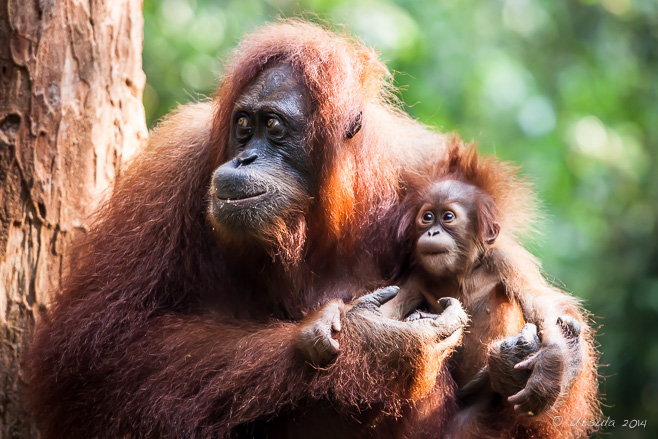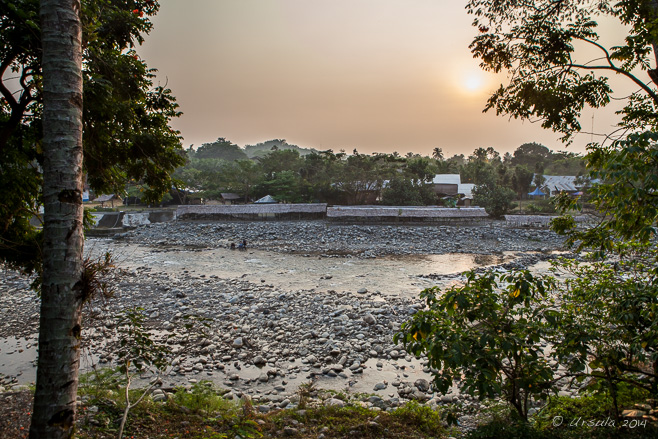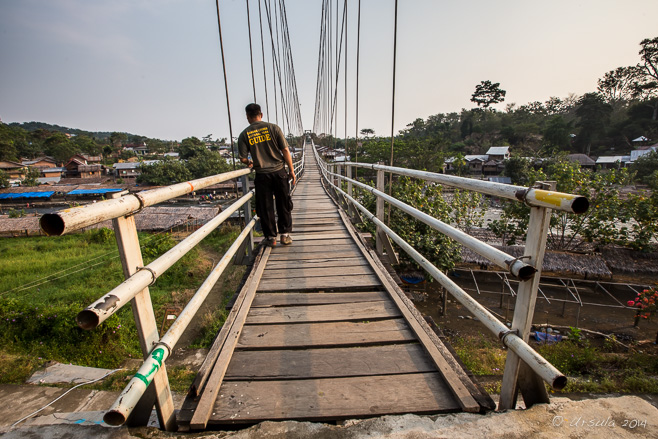
Sandra and Her Baby
A rehabilitated semi-wild orangutan (Pongo abelii) visits the feeding station in Gunung Leuser National Park with her young baby.
Never have I felt more like David Attenborough.
You know: in that classic, ground-breaking twelfth episode of Life on Earth (1979), investigating primates and their “Life in the Trees”, where the broadcaster and naturalist finds himself face to face with an adult female mountain gorilla in Rwanda, and turns to talk softly to the cameras.
We were in Asia, not Africa, and they were orangutans, not gorillas, but as I crouched in a jungle clearing, talking softly while a wild primate walked not four feet away from me, I felt that sense of awe and momentary connection. There is something magic about making eye-contact with a sentient ‘forest person’ (orang utan in Malay) in her own environment.
We had been in the jungles of Gunung Leuser National Park in North Sumatra for over three hours, much of it trekking across steep, slippery and narrow trails before our “wild” encounters, and we were having a wonderful morning.
Join me on a rare opportunity to visit a small portion of the UNESCO World Heritage site 1167: ‘The Tropical Rainforest Heritage of Sumatra’.

Sun on the Bahorok River
Just two weeks before our stay at Bukit Lawang, volcanic Mount Sinabung, about 50 km south as the crow flies, erupted, killing at least 14 people. The volcanic ash still hung thick in the air, like smoke.

Bridge to Bukit Lawang
From our “Ecolodge”, we crossed …

Bathing Huts on the Shore
… over the Bahorok River, where the locals were picnicking and bathing, …

Rusty Roofs
… into the small tourist village of Bukit Lawang.

Bukit Lawang Locals
Local Indonesians watch our progress through the muddy ‘main street’.

Dinghy-Ferry
Access to the Gunung Leuser National Park is by inflatable dinghy.

Happy Boatman
The boatman who steered us across the river thought we were pretty entertaining.

Sepi and the Ranger
The first orang-utan to visit the feeding station, located a short walk into the park, was seventeen-year-old Sepi.

Sepi and her Baby
Her two-and-a-half-year-old baby never left her side.

Park Ranger
At the Bukit Lawang Rehabilitation Centre, orangutans who had been rescued from captivity were taught the skills necessary to survive in the wild, and released into Gunung Leuser National Park. More than 200 orangutans have been released, and the rangers monitor their progress. The daily feedings at the platform help the orangutans supplement their diets until they can be fully independent. It also allows visitors a view of the semi-wild primates.

Sandra and Her Baby
The second orangutan to visit the feeding platform was 40-year-old Sandra with her fourth, and presumably last, baby. Female orangutans have eight-year intervals between babies; for the first four months, infants cling to their mothers, and they are completely dependent for two years.

Long-Tailed Macaque
Clearly not the alpha-male, this macaque (Macaca fascicularis) had been in the wars and lost: his facial and leg injuries looked recent. He kept a careful watch as he picked over the scraps left on the feeding platform.

Through the Jungle
Our guide asked us if we were feeling ‘strong’, and then led us into the jungle on the not-so-easy path…

Lost?
… up hills so steep we were clinging to vines and roots, and through foliage so thick we often lost sight our guides.

Thomas Leaf Monkey
Our sharp-eyed guides found some delightful blue-grey and white Thomas’s Langurs (Presbytis thomasi).

Thomas Leaf Monkey
Endemic to Sumatra, this vulnerable monkey – like the orangutan – is threatened by habitat loss.

Thomas Leaf Monkey
As long as the guides had bananas, the monkeys were happy to visit us.

Thomas Leaf Monkey
With their mohawks and whiskers, they are very cute.

Official Park Guide
Ayub, one of our guides, was adept at spotting and calling animals. The use of official guides is important for the care and protection of the animals – and for the livelihood of the local community.

Swinging In
Orangutans, especially the Sumatran ones, spend nearly all their time in the trees. Ratna swung in to see what our guides had to offer when she heard Ayub calling her.

Ratna
She dropped to the ground, and it was wonderful to be so close to her as she walked past me to retrieve a carrot.

Juvenile
Ratna’s youngster, a gorgeous little fluff-ball, stayed safely up in the trees.

Ratna and her Juvenile
Juveniles are usually weaned at about four years of age – so this one won’t be nursing much longer.

Orangutan
The guides had no name for the last orangutan we met because she was born in the wild.
During his encounter with the gorillas, (Sir) David Attenborough said: “There is more meaning and mutual understanding in exchanging a glance with a gorilla than with any other animal I know.”
Looking into the gentle brown eyes of the critically endangered Sumatran orangutans, the same could be said.
As soon as we walked out of the park boundaries, we were back in the rubber plantations, much like those we’d seen, mile after mile, on the drive from Medan the day before.

Young Rubber Plantation
Rubber trees stretch into the distance, making it easy to see how challenging it is to protect the remaining small patches of wild habitat.

The less-than-7000 remaining Sumatran orangutans inhabit only a tiny corner of the planet –
We need to help them keep it.
Pictures: 16February2014




























.png)


Ursula, as usual I enjoy your reports and images. Warm greetings, Dietmut
Thank you, Dietmut! I am always happy for your visits. 🙂
Very well done
Excellent coverage, Ursula. Your images and story make this special part of the world come to life. Thanks for a delightful trip down Memory Lane.
Thank you, again, Ursula! What an amazing experience!!
Thanks, Susan, Gabe and Melissa. 🙂
As Gabe and Melissa know first hand, it is indeed a special place.
[…] the breathtakingly awesome experience of meeting Sumatran orangutans in their wild jungle habitat (Ursula’s Weekly Wanders: Meet the Locals). Truly, it was a memorable encounter – one not easily […]